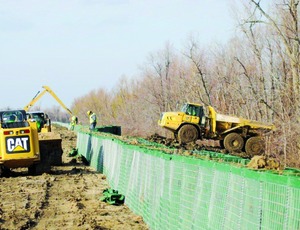
Emerging from the Mississippi River and Tributaries System's worst flood season in history, the U.S. Army Corps of Engineers and its contractors are gearing up to deliver $802 million worth of repair and reconstruction—more than three times the MR&T's annual operating budget—while continuing to battle ongoing fall and winter floods as well.
The funds dedicated to MR&T repairs are part of $1.7 billion appropriated to the Corps under the Disaster Relief Appropriations Act signed by President Barack Obama on Dec. 23. The amount is well shy of the Corps-estimated, $2-billion top-to-bottom cost to repair all system damages from the 2011 floods, but it is enough to "aggressively attack most of our critical-safety projects," says Scott Whitney, regional flood risk manager in the Corps' Mississippi Valley Division.
Only three of the system's top-10 critical repair projects have been completed so far.
By Nov. 30, the Corps had identified $960 million in repair work it deemed most critical to protect life and safety. And under funding levels current at that time, it calculated that it would take as long as 15 years to complete the work. But with the new appropriation, "this will take about three years—which is a hell of a lot better," says Whitney.
Now that the $802 million is available, the Corps is challenged with determining how best to expedite the work. "We've got a tall order in front of us right now, but our division just finished the biggest program in Corps history—the more than $14-billion program in New Orleans that was executed over four or five years," Whitney says. He says the division can handle the new workload.
Whitney says the Corps' strategy is to determine which activities can only be handled internally, such as mat sinking, and which can be parceled out to the contracting community. "We will be letting some huge contracts across the region to get this done quickly," he says.
About 20 projects are poised to enter construction but are now postponed until the spring because the fall flood fight still continues. Although the money has been allocated for 18 of those projects, only half are fully funded, and other preparations must be concluded. "We're still working on plans and specs, acquisitions, real estate and environmental issues," Whitney says. "A lot of things have to happen before you can turn loose the bulldozers."
That means communities are entering another flood season with numerous, known weaknesses all along the MR&T.
The Corps has an interactive website to provide status and construction fact sheets on all the projects. Click on "Operation Watershed" for further information.

Post a comment to this article
Report Abusive Comment